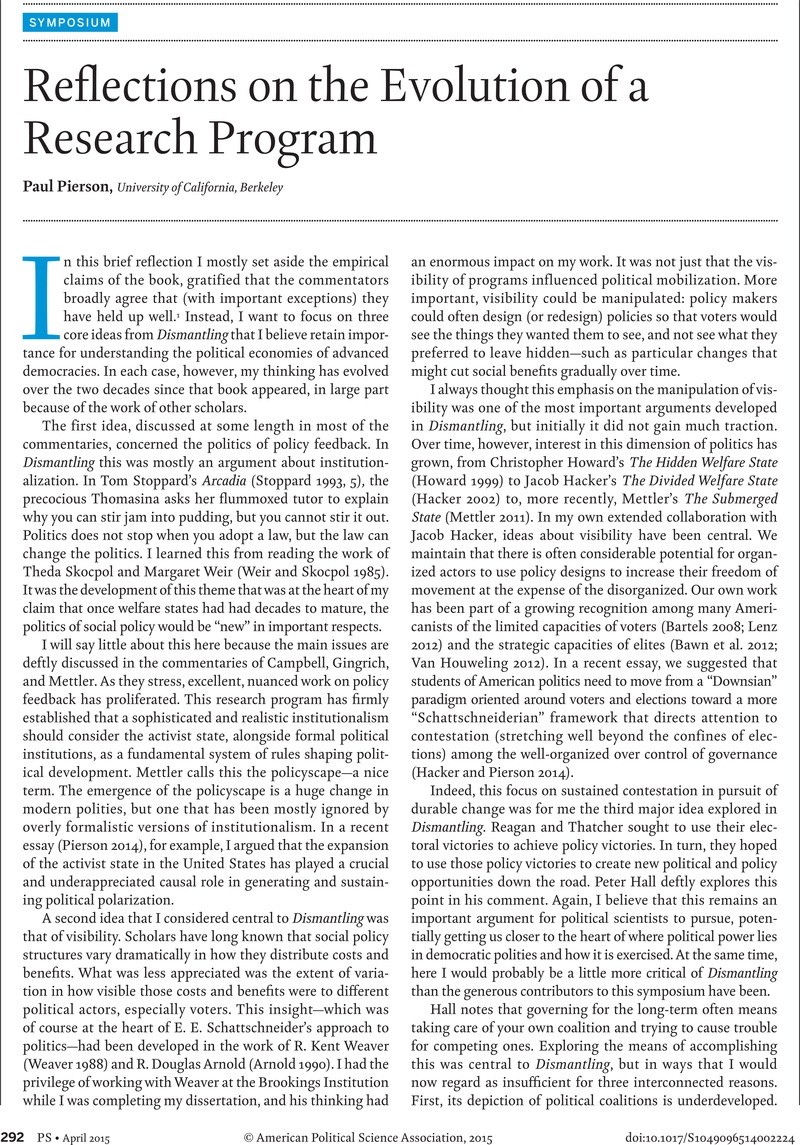No CrossRef data available.
Article contents
Reflections on the Evolution of a Research Program
Published online by Cambridge University Press: 02 April 2015
Abstract
An abstract is not available for this content so a preview has been provided. Please use the Get access link above for information on how to access this content.

- Type
- Symposium: Paul Pierson’s Dismantling the Welfare State: A Twentieth Anniversary Reassessment
- Information
- Copyright
- Copyright © American Political Science Association 2015
References
REFERENCES
Arnold, R. Douglas. 1990. The Logic of Congressional Action. New Haven, CT: Yale University Press.Google Scholar
Bartels, Larry. 2008.
Unequal Democracy: The Political Economy of the New Gilded Age
. Princeton, NJ: Princeton University Press.Google Scholar
Bawn, Kathleen, Cohen, Martin, Karol, David, Masket, Seth, Noel, Hans, and Zaller, John
2012. “A Theory of Political Parties.” Perspectives on Politics
10 (3): 571–97.Google Scholar
Hacker, Jacob S. 2002. The Divided Welfare State: The Battle over Public and Private Social Benefits in the United States. Cambridge: Cambridge University Press.Google Scholar
Hacker, Jacob S. 2004. “Privatizing Risk without Privatizing the Welfare State: The Hidden Politics of Social Policy Retrenchment.” American Political Science Review
98 (2): 243–60.CrossRefGoogle Scholar
Hacker, Jacob S., and Pierson, Paul. 2010. Winner-Take-All Politics: How Washington Made the Rich Richer and Turned Its Back on the Middle Class.
New York: Simon and Schuster.Google Scholar
Hacker, Jacob S., and Pierson, Paul. 2014. “After the ‘Master Theory’: Downs, Schattschneider, and the Rebirth of Policy-Focused Analysis.” Perspectives on Politics
12 (3): 643–62.Google Scholar
Hacker, Jacob S., and Pierson, Paul (forthcoming). American Amnesia: The Forgotten Foundation of Our Shared Prosperity. New York: Simon and Schuster.Google Scholar
Howard, Christopher. 1999. The Hidden Welfare State: Tax Expenditures and Social Policy in the United States. Princeton, NJ: Princeton University Press.Google Scholar
Lenz, Gabriel. 2012. Follow the Leader? How Voters Respond to Politicians’ Policies and Performance. Chicago: University of Chicago Press.Google Scholar
McCarty, Nolan, Poole, Keith, and Rosenthal, Howard. 2006. Polarized America: The Dance of Ideology and Unequal Riches.
Cambridge, MA: MIT Press.Google Scholar
Mettler, Suzanne. 2011. The Submerged State: How Invisible Government Policies Undermine American Democracy. Chicago: University of Chicago Press.Google Scholar
Pierson, Paul. 2014. “Madison Upside Down: The Policy Roots of Our Polarized Politics.” In The Politics of Major Policy Reform in Postwar America, eds. Jenkins, Jeffery A. and Milkis., Sidney M.
Cambridge: Cambridge University Press.Google Scholar
Van Houweling, Robert. 2012. “Parties as Enablers: Individual Incentives for Partisan Legislative Organization.” Unpublished manuscript. University of California, Berkeley.Google Scholar
Weaver, R. Kent. 1988. Automatic Government: The Politics of Indexation. Washington, DC: The Brookings Institution.Google Scholar
Weir, Margaret, and Skocpol, Theda. 1985. “State Structures and the Possibilities for ‘Keynesian’ Responses to the Great Depression in Sweden, Britain, and the United States.” In Bringing the State Back In, ed. Evans, Peter B., Rueschemeyer, Dietrich, and Skocpol., Theda
Cambridge: Cambridge University Press.Google Scholar


